Studio Visit
Pipilotti Rist Is Still Toying With the Fabric of Reality
The artist's first survey in the Middle East "Electric Idyll" is now on view at Fire Station Galleries in Doha.
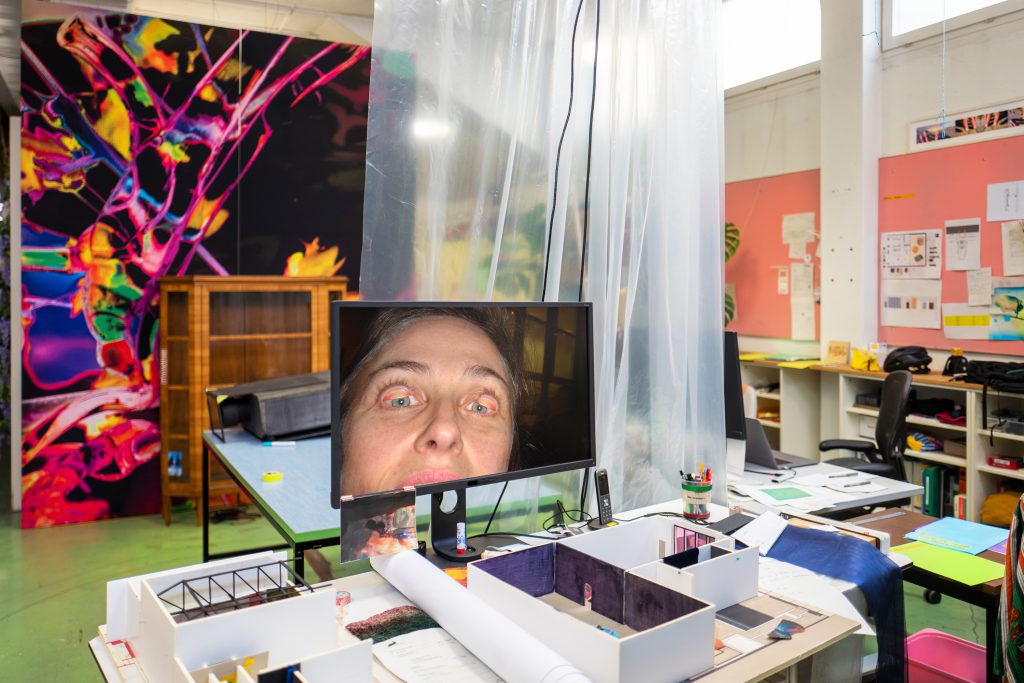
Pipilotti Rist’s Zurich studio doesn’t disappoint. It’s just as zany, kaleidoscopic, and creatively cluttered a space as one would imagine the celebrated Swiss artist inhabiting. For the past 30 years, Rist has concocted her lavishly imagined immersive worlds—from her hypnotic “Pixel Forests” to dream-like films, right here, in an underground studio in Zurich’s Little Italy that she calls her “digital cave.”
The studio is a space of playful contradiction, feeling at once sprawling and cozy, stuffed with costumes one moment, like the backstage of a theater, and appearing as a high-tech laboratory the next. Some days the mood of the space is bustling—Rist has a devoted cadre of full- and part-time teammates who bring her visions to life. But in other moments, it becomes a solitary oasis where the artist can toil with almost monastic focus.
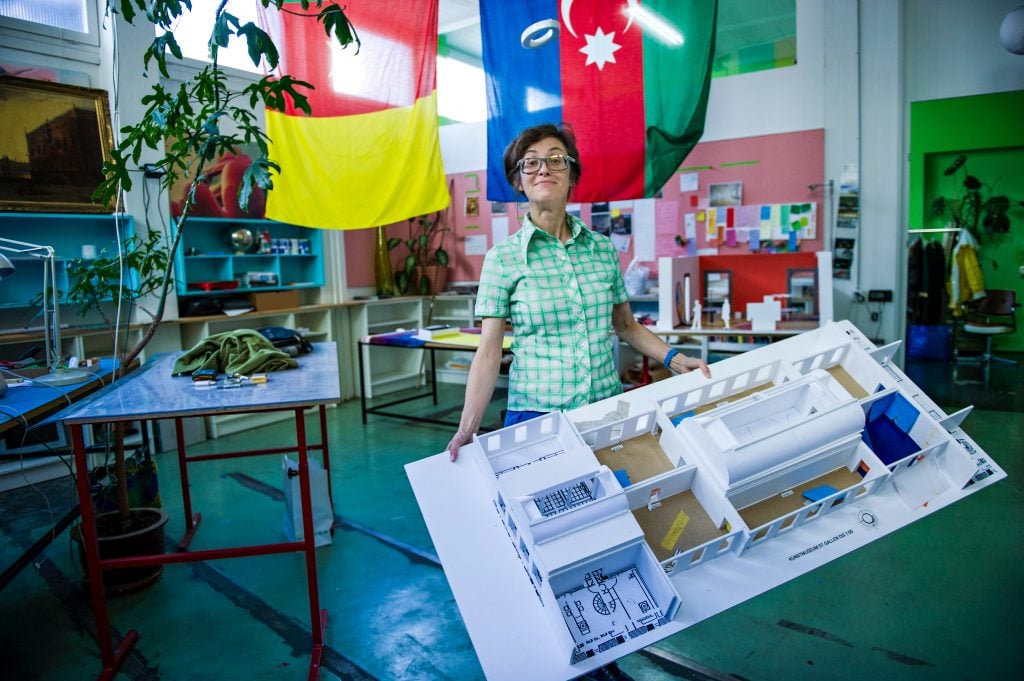
Portrait of Pipilotti with cardboard model by Dave Lang. Courtesy of the artist.
Right now, Rist is the subject of her first survey exhibition in the Middle East, “Electric Idyll” at Doha’s Fire Station’s gallery spaces (through June 1). The exhibition brings together a mix of significant historical works from the 1990s and new productions. But this is no stuffy career overview. Instead, Rist offers up a communal, participatory setting, that she calls a “hypnotic diorama” interweaving textiles, furniture, installations, and video projections. Among the star moments of the exhibition is Ever is Over All (1997)—the video installation that won Rist Best Young Artist at the Venice Biennale in 1997. This survey marks Rist’s second installation in Doha, following Your Brain to Me, My Brain to You (2022) which was on view at the National Museum of Qatar until earlier this year.
Recently, we caught up with Pipilotti Rist at her Zurich studio and talked about this unique exhibition, how she breaks out of a creative slump (hint: bring tissues), and the “Pixel Forest” she has in the works for… an actual forest.
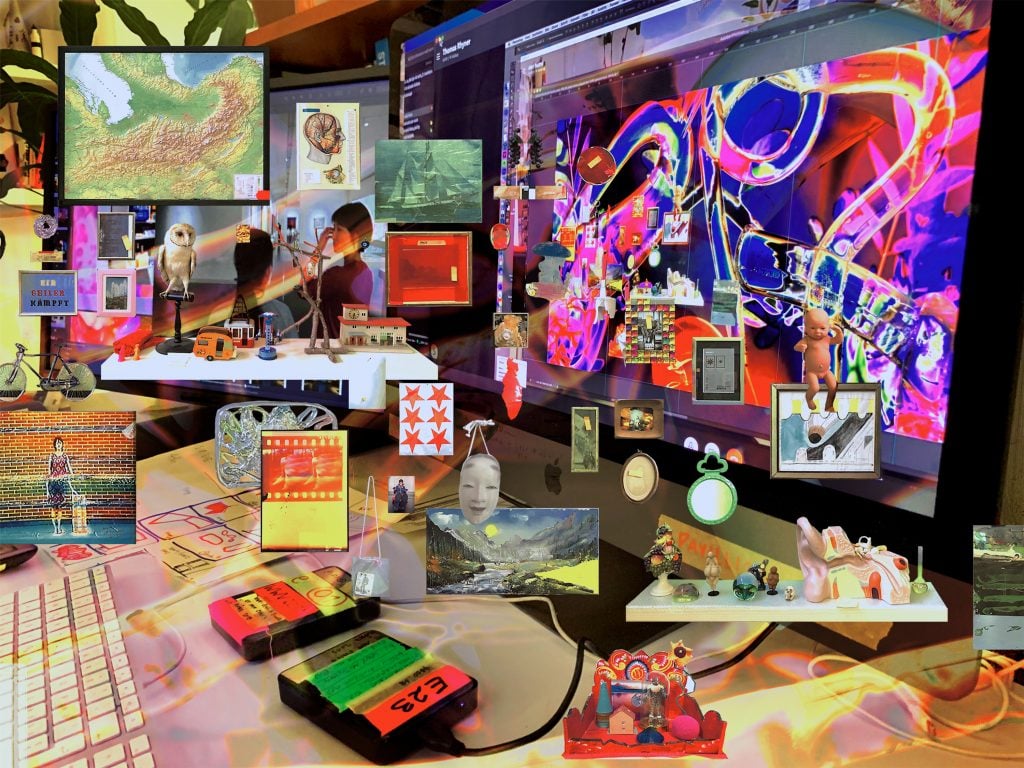
Pipilotti’s desktop in progress. Montage with Thomas Rhyner. Courtesy of the artist.
You’ve been in the same studio for decades. Can you tell us where it is and what it’s like?
Imagine a forgotten swimming pool. For 30 years, it’s been my hidden underground workshop in Zurich’s Little Italy. Sunlight peeks through, but the outside world remains hidden. Instead, you’ll find the whir of tools, a kaleidoscope of fabrics, and miniature rooms under construction. I’m drawn to the potential of things: plastics, toys, the discarded bits that fuel my installations. Patterns emerge and materials are tested for how they shape light and sound. Multimedia? Perhaps. But I prefer the raw simplicity of our senses—the eye as blood-driven cameras, the sun as our grandest projector. This studio, my digital cave, is where the past informs the unexpected.
Right now, “Electric Idyll,” your first survey in the Middle East is on view. How did this exhibition come about?
Two years ago, I had the honor of creating “Your Brain to Me, My Brain to You” a large-scale installation for the National Museum in Doha. It is a site-specific development of the “Pixel Forest,” inviting viewers to walk within a three-dimensional video installation that “explodes” within the room, precisely edited to the sound.
I was so deeply touched by the number of people who came to make this experience. I also embraced the initiative of the museum to use it as a starting point to encourage people to speak about their emotions.
Following my installation at the National Museum, the visionary Sheikha Mayassa al Thani [Chairperson of Qatar Museums] and Qatar Museums proposed an exhibition showcasing the evolution of my work. Collaborating with the smart curator Massimiliano Gioni and my amazing team, we wove a single installation defying the concept of a traditional survey. Works whisper to each other across decades—1990s relics converse with 2024 visions—intertwine in a multi-layered environment.
Can you describe the exhibition to those who might not be able to see it in person?
The heart of the exhibition thrums with enigmatic still lifes, immense and strangely familiar. Sink into plush landscapes where images flicker and dance upon the very fabric of reality. We call these “electric islands,” a place where the boundary between the viewer and the viewed dissolves. After all, aren’t our minds the ultimate vessels for images, swirling with echoes of the past and glimpses of the impossible
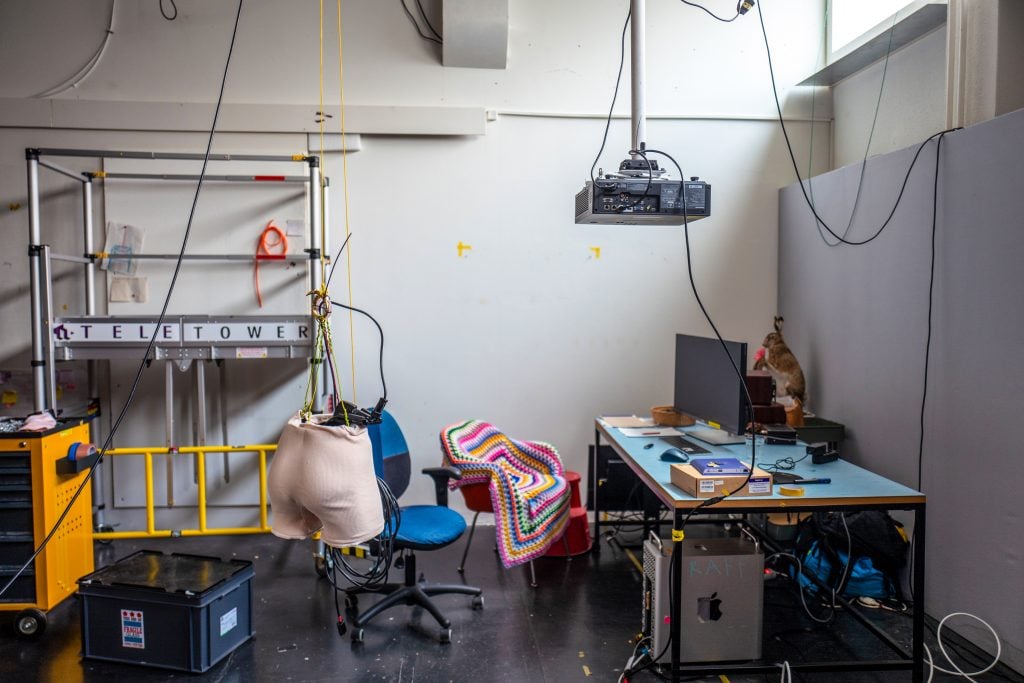
Studio still life. Courtesy of the artist.
When you’re conceptualizing a show like this, which includes many works, how do you mock them up? Do you use computer software or models or both? Do you generally have a preferred method for preparing a work?
We start with a cardboard model, like a dollhouse with miniature furniture. We even mock projections with paper prints. Then, we do real-size prototypes in the studio, experimenting with color and form. We finalize things digitally using architectural software and the space plans. For video works, I start with a theme, shoot tons of footage, narrow it on the computer, but test it all in the studio, as close to installation scale as possible.
Can you tell me about the team you work with? What’s a day in your studio like? Are you ever alone?
My studio is a place of both solitude and creative kinship. It is like a small film company, where we build the stage sets for my ever-evolving visions.
I have three incredible full-time collaborators—Nike Dreyer, Dave Lang, Patrica Dangel – and a dedicated team of part-timers: Anne Ciresa, Danielle Küchler Flores, Thomas Rhyner, Remo Weber, Tamara Rist, and Antshi von Moos. We thrive on additional collaboration with light designer Kaori Kuwabara and London-based architects Andreas Lechthaler & Sebastian Koepf of Klaud as well as with also Käthe Walser.
Yet, even amidst this artistic family, I am often alone in the quiet hours.
What are you working on now?
My work is in a state of constant evolution. I plan years ahead and juggle multiple projects at once. Right now, I’m working on a weatherproof “Pixel Forest” for an actual forest—a five-year collaboration with light designer Kaori Kuwabara. True innovation demands experimentation. My designs only fully emerge within the places they’re destined for, whether that’s a forest or another unexpected space. My studio? It’s the rehearsal room, where I build a stage for the visitor’s experience.
What atmosphere do you prefer when you work?
My ideal workspace balances individual focus with collaboration in the team. There’s a quiet energy, punctuated by spontaneous discussions with my team as ideas or problems emerge. We’ve found a productive rhythm – focused work sessions interspersed with short, dynamic meetings. This constant shift in intensity keeps me and my team energized and moving forward.
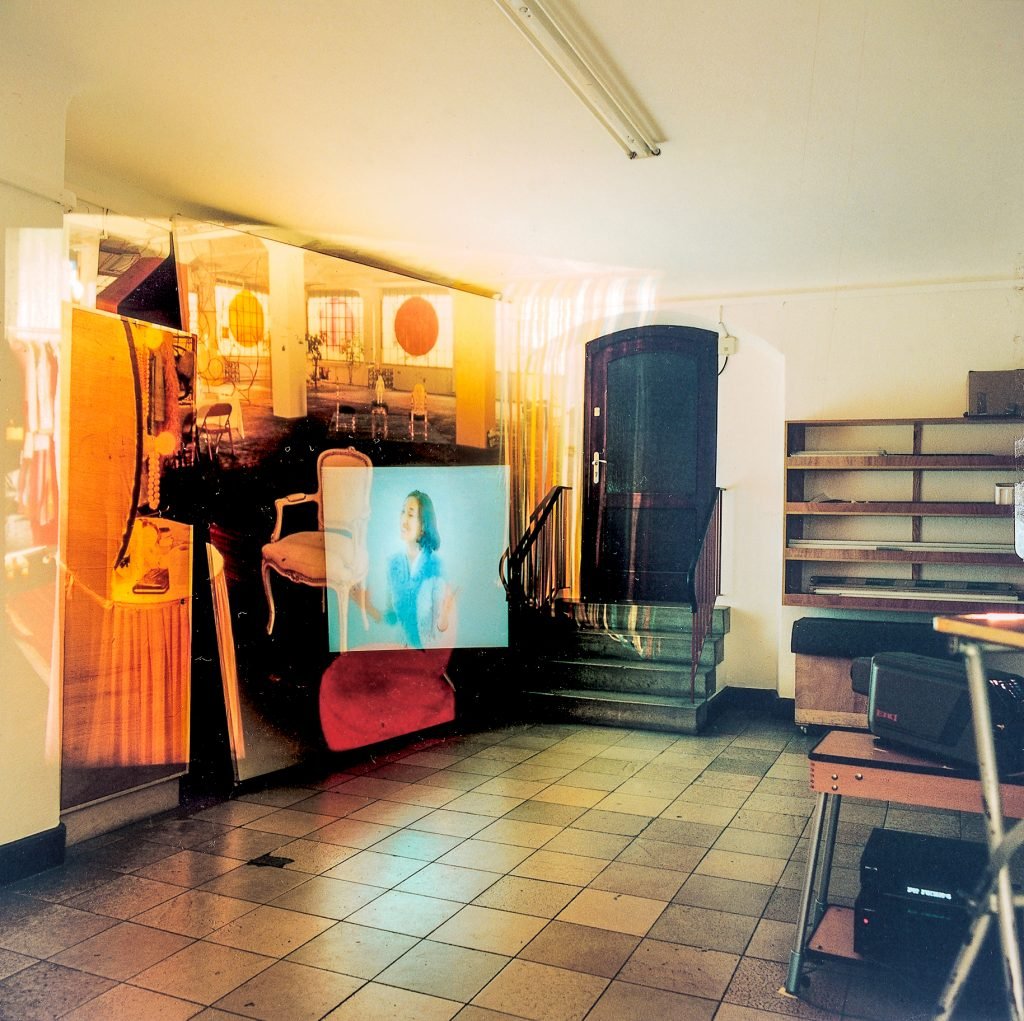
Studio still life. Courtesy of the artist.
Is there anything you like to look at or read or listen to while in the studio for inspiration or as ambient culture?
My huge collection of postcards transports me around the world, into different times and social classes. The vibrant snippets of writing from different places always keep me flowing. I also adore science books that reveal the hidden patterns and incredible forces shaping our world and beyond. Another source is talking to strangers as they offer fresh perspectives. We have many plants in the studio, some are climbing up the video, audio, and electrical cables. Observing their growth reminds me of the power of resilience and finding creative solutions.

Panorama of the Pipilotti Rist studio. Courtesy of the artist.
When you feel stuck while preparing for a show, what do you do to get unstuck?
When I hit a creative roadblock, I employ a few techniques. Sometimes, I just cry or take a brisk walk at the nearby cemetery or I discuss with my talented collaborators. Fortunately, I have the privilege of working with strong curators whose expertise allows them to offer fresh viewpoints and help me navigate creative hurdles, so I slowly climb out of the dirt.
What implement or art supply do you enjoy working with the most, and why?
My most essential art supply is envisioning a future being who will experience my installations. Bringing environments with caressing lights to life requires meticulous logistics, so I rely on the software Notion to keep tasks and timelines on track. It saves us emails.
My lover is the small ladylike camera, my Sony A73 IIIS with its different Laowa lenses. I am married to the editing software Davinci Resolve and I love the Canadian Software TouchDesigner for creating and altering pictures to bring them closer to the necessary. We regularly do little dance sessions, where we dance together trying to do it as ugly as possible.





